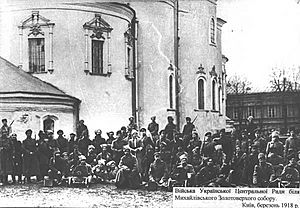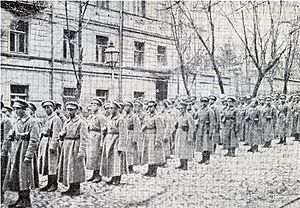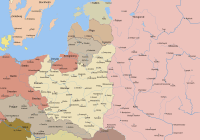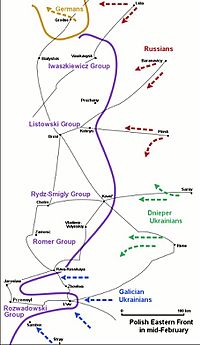Ukrainian–Soviet War facts for kids
Quick facts for kids Soviet–Ukrainian War |
|||||||||||
|---|---|---|---|---|---|---|---|---|---|---|---|
| Part of Ukrainian War of Independence and Russian Civil War | |||||||||||
 UPR soldiers in front of St. Michael's Golden-Domed Monastery in Kyiv. |
|||||||||||
|
|||||||||||
| Belligerents | |||||||||||
|
(1920–21) |
Various independent rebels |
||||||||||
| Commanders and leaders | |||||||||||
The Ukrainian–Soviet War was a big conflict in Ukraine between 1917 and 1921. It was mainly fought between the Ukrainian People's Republic (who wanted Ukraine to be independent) and the Bolsheviks (who wanted Ukraine to be part of Soviet Russia). The war started after the October Revolution in Russia, when Lenin sent his troops into Ukraine.
In the past, Soviet historians said this war was about freeing Ukraine from Western European armies. But today, Ukrainian historians see it as a fight for independence that sadly failed.
Contents
Understanding the Conflict
Historians often see this war as part of the bigger Russian Civil War. In Ukraine, it was a fight between the Ukrainian national government, led by Symon Petliura, and the Bolshevik government, led by Lenin.
The war happened in three main parts:
- December 1917 – April 1918: This was a time of big changes. Bolshevik groups started uprisings and invaded Ukraine. Later, Ukraine signed a special agreement and pushed the Bolsheviks out.
- December 1918 – December 1919: This was a civil war within Ukraine. The Red Army invaded again. Ukraine tried to unite its different parts. There were also peasant uprisings against the Soviets. Ukraine lost its western part to Poland.
- Spring 1920 – Autumn 1921: This period included the Polish–Soviet War. Ukrainian fighters continued their struggle, even with a government in exile.
Key Agreements and Treaties
Several important documents shaped this war:
- Declarations of the Central Council of Ukraine: These were official statements by the Ukrainian government.
- Ultimatum of Sovnarkom: This was a demand from the Soviet government to Ukraine.
- Treaty of Brest-Litovsk: This agreement gave Ukraine a neutral status and military protection from Central European powers.
- Unification Act: This document officially united western Ukraine.
- Treaty of Warsaw: This was an agreement between Poland and Ukraine against the Bolsheviks.
- Peace of Riga: This treaty divided Ukraine between the Bolsheviks and Poland.
How the War Began
After the February Revolution in 1917, many groups in the Russian Empire wanted to rule themselves. Ukraine was one of them. In the summer of 1917, a temporary Russian government allowed Ukraine to have its own regional government.
In October 1917, the Ukrainian government said it would fight against any attempt by the Bolsheviks to take power in Ukraine. There were street fights in Kyiv, and pro-Bolshevik troops eventually gave up. On November 20, 1917, the Ukrainian Central Rada (Council) declared Ukraine as the Ukrainian People's Republic. It was meant to be a self-governing part of the Russian Republic.
On December 17, 1917, the Bolsheviks sent a strong warning to the Rada. They demanded that Ukraine stop its "counter-revolutionary actions" or get ready for war. The Rada did not agree to the demands. Instead, they asked for their independence to be recognized. The same day, the All-Ukrainian Congress of Soviets in Kyiv supported the Ukrainian government. The Bolsheviks in Kyiv then left and held another meeting in Kharkiv.
At the Kharkiv meeting, the Bolsheviks declared their own Ukrainian People's Republic of Soviets. They called the Central Rada an enemy and declared war on January 2. The Rada then cut all ties with Russia on January 22, 1918, and declared full independence. This officially started the Ukrainian War of Independence. Soon after, Russian Bolshevik troops began invading Ukraine.
Key Moments of the War
Early Battles (December 1917 – April 1918)
The Bolshevik forces had about 30,000 soldiers. They were made up of regular Russian army troops and Red Guard groups. They advanced from the northeast. The Ukrainian forces were much smaller, with about 15,000 volunteers and special units.
As the Bolsheviks moved into Ukraine, local Bolsheviks started uprisings in cities. They captured Kharkiv (December 26), Yekaterinoslav (January 9), and Poltava (January 20). Their goal was to reach Kyiv.

On January 29, 1918, a small Ukrainian unit of less than 500 schoolboys and cadets fought bravely in the Battle of Kruty. About half of them were killed trying to stop the Bolshevik advance.
At the same time, a Bolshevik uprising started at the Kiev Arsenal factory in Kyiv. After six days of fighting, Ukrainian forces stopped the uprising. However, on February 8, the Ukrainian government left Kyiv to avoid destruction. Bolshevik troops then entered Kyiv on February 9.
But on February 9, the Ukrainian People's Republic signed the Treaty of Brest-Litovsk. This brought aid from German and Austro-Hungarian troops. Over 450,000 foreign soldiers helped Ukraine. In return, Ukraine had to send food to these Central Powers. These combined forces pushed the Bolsheviks out of Ukraine and took back Kyiv on March 1. The fighting continued, and by June 12, the Bolsheviks were forced to sign a peace treaty with Ukraine.
After the Hetmanate (1918-1919)
In November 1918, a new Ukrainian government called the Directorate of Ukraine took power. German forces, who were leaving after World War I, stayed neutral. The Directorate brought back the Ukrainian People's Republic. On January 22, 1919, different Ukrainian republics united.
To stop a new war with the Bolsheviks, the Ukrainian government sent a group to Moscow. They signed a peace agreement, but it didn't stop the fighting. Bolshevik groups kept crossing the border into Ukraine.
Bolshevik Invasion (January – June 1919)
On January 7, 1919, the Bolsheviks launched a full-scale invasion of Ukraine. The Directorate declared war on Russia again on January 16. The main targets for the Bolsheviks were Kyiv and Kharkiv.
On January 3, the Red Army took Kharkiv. Ukrainian forces, which had over 100,000 men, shrunk to about 25,000 due to soldiers leaving. On January 6, 1919, the Bolsheviks officially created the Ukrainian Socialist Soviet Republic. Russia claimed that the fighting was only between Ukrainian groups, not involving the Russian army.
By February 5, the Soviets had taken Kyiv, forcing the Ukrainian government to move to Vinnytsia. The Bolsheviks continued to gain ground. However, by the end of March, Ukrainian armies fought back successfully. They took back several cities and threatened Kyiv again. By early June, Ukraine launched another attack, taking back the Podolia region.
Summer and Autumn (July – December 1919)
The Red Army fought back against the Ukrainian attack. But Ukraine got stronger when General Yurii Tiutiunnyk and his experienced troops arrived. The Ukrainian army counterattacked, pushing the Red Army back. Troops from the Ukrainian Galician Army also joined the fight. This gave Ukraine a combined force of 85,000 regular soldiers and 15,000 partisan fighters.
By October 1919, many Ukrainian soldiers became sick with typhus, which weakened their forces.
Winter Campaigns and Polish Alliance (December 1919 – November 1920)
From December 1919 to May 1920, the UNR Army carried out a secret operation called the First Winter Campaign. They fought behind Red Army lines. Another important event was the Treaty of Warsaw with Poland on April 22. This led to a joint attack with Polish troops against the Bolsheviks.
On May 7, a Ukrainian division entered Kyiv, but the Red Army quickly pushed them out. The Ukrainians and Poles were pushed back towards Warsaw. The Poles then signed a peace agreement with the Soviets on October 12. Ukrainian forces kept fighting until October 21, when they were forced to go into Polish territory. There, they were disarmed and held in camps.
Final Efforts (November 1921)
The last major action by the Ukrainian People's Republic against the Soviets was a raid in November 1921, known as the Second Winter Campaign. This plan was to encourage Ukrainian farmers to rise up against the Soviets and unite all anti-Bolshevik fighters.
Two groups of Ukrainian soldiers tried to cross into Soviet territory. One group returned to Poland. The other group captured Korosten but was later surrounded by Bolshevik cavalry. Many Ukrainian soldiers were captured, and 359 of them were shot on November 23.
This was the last military operation of the UNR army against the Soviets. The war officially ended, but some small groups continued fighting until mid-1922. The Red Army responded by using harsh methods against people in the countryside.
Local Rebellions
Some local groups who supported the Ukrainian People's Republic created their own independent areas, like the Independent Medvyn Republic and the Kholodny Yar Republic. They continued to fight against the Russians and their supporters until 1923.
What Happened Next

After the war, most of Ukraine became the Ukrainian Soviet Socialist Republic. On December 30, 1922, this republic became one of the first parts of the Union of Soviet Socialist Republics (USSR). Parts of Western Ukraine came under the control of Poland, as decided by the Peace of Riga. The Ukrainian People's Republic government, led by Symon Petlura, had to go into exile.
For a few years, Ukrainian nationalists tried to fight a guerrilla war against the Soviets. They got some help from Polish intelligence. However, they were not successful. The last active Ukrainian groups were mostly wiped out during the Holodomor, a terrible famine. Also, because Poland didn't fully support the Ukrainian cause, it led to bad feelings between Ukrainians and Poles in the years that followed.
|
See also
 In Spanish: Guerra soviético-ucraniana para niños
In Spanish: Guerra soviético-ucraniana para niños


